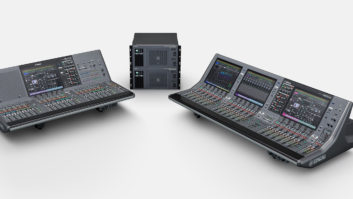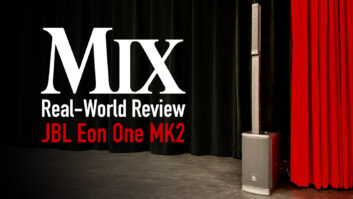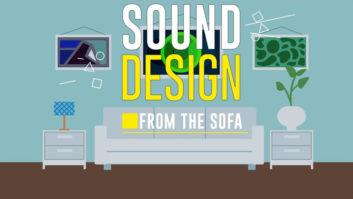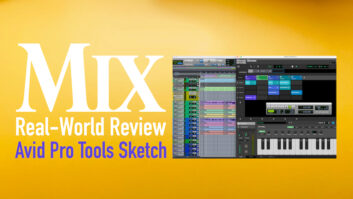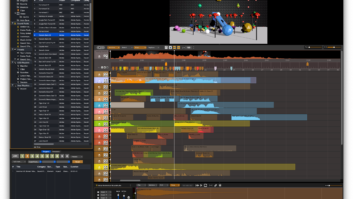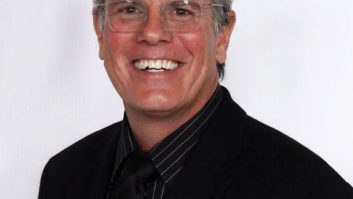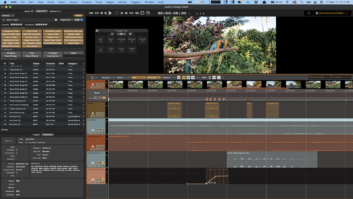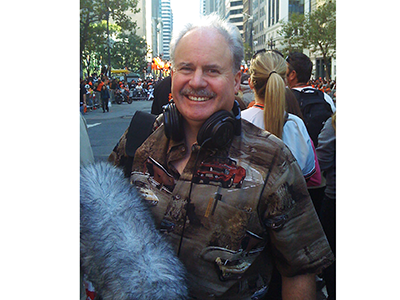
You’ll find it hanging on the museum wall, right next to cassette tape and the stone tablet. It’s official, the CD is history. At least in the world of sound effects libraries. Rob Nokes, founder/president of Sounddogs in Los Angeles, the largest online sound effects library, says he’d be hard pressed to sell libraries on CD, even at a discount. Brian Nimens of Sound Ideas in Toronto adds, “I never thought I’d see the death of the compact disc.”
Well, now he has. Nimens, founder/president of Sound Ideas—which celebrated its 37th birthday in March, remembers selling his first copies of the Series 1000 library on reel-to-reel. “It would take us a whole week to duplicate 10 copies of the library, and then we would ship them out on Friday.” Now distribution happens via hard drive and download, though clients barely want to wait two days for a hard drive delivery. “People want it yesterday, or at the very latest, right now,” jokes Nimens. He reveals that Sound Ideas is creating a new website where customers can instantly download the smaller libraries Sound Ideas has to offer. “We’re hoping the website will be ready for premiere around the NAB show.”
Recently, Nokes and Nimens were involved in a major rearrangement in the sound community. When Todd-Soundelux closed up shop, Nokes purchased all of Todd-Soundelux’s library assets and trademarks, which included The Hollywood Edge. “I was after the jewel, which I believe was Soundelux. Their best material was kept in-house because they didn’t want to provide their competitive advantage to other sound editing companies. Soundelux is an incredible sound effects library.”
Nokes sold The Hollywood Edge to Nimens at Sound Ideas. “We were lucky enough to be able to purchase The Hollywood Edge,” Nimens says. “I look at it as a big fish eating a little bit smaller of a fish. I always felt as if Sound Ideas was number one and The Hollywood Edge was number two. So, with me swallowing up The Hollywood Edge, it’s made us, without a doubt, the largest publisher of sound effects in the world today.”
The takeaway: The Hollywood Edge gets to live on under the protection of its longtime rival Sound Ideas (think Rome expanding its empire), and Nokes is free to license the treasure trove of beautifully recorded Soundelux effects to the audio community, as a complete collection for clients with deep pockets—like Wild Tracks, Technicolor, King Soundworks, Warner Bros., and Formosa Group. “I think our business is really moving toward licensing big libraries now to big clients,” observes Nokes. Additionally, 250,000 Soundelux effects will be available on an à la carte basis through Sounddogs.com.
Even more consolidation could be on the horizon due to oversaturation in the sound library market. With recording technology getting cheaper and better, Nokes observes, “There is a lot more average content recorded by semi-professional recordists. That’s causing a lot of saturation in the market. You don’t need a huge investment or experience to capture an average recording.”

“With word-press templates and shopping systems, everyone can click together a shop almost instantly,” adds Axel Rohrbach, creative director of BOOM Library in Mainz, Germany—a high-res sound library company started in 2010 by audio pros from award-winning game sound company Dynamedion.
Despite the sea of sound effects to search through online, Ric Viers, founder/owner of the ever-growing Blastwave FX located in Detroit, Mich., believes the cleanest, most useful sound libraries will rise to the top. But one negative impact of oversaturation is downward pressure on pricing. “There’s a lot more people making sound effects libraries, and so everyone is giving it away for pennies on the dollar,” explains Viers. “It’s really sad to see somebody spend hours designing or creating something, and then you can download it on a website somewhere for a $1.99.”
What It Takes
Tremendous work goes into releasing a sound effects library, from capturing, cleaning and curating the sounds to selling the collection, either as downloads or on a drive. But how much longer will customers want to buy a hard drive library? Will hard drives join the CD as an outmoded form of distribution? Rohrbach notes that some companies don’t even offer hard copies of their libraries, and only offer digital distribution. “We all tend to want to use everything we bought right away; however, downloading several gigabytes can take some time, even with high-end, cloud-based content delivery systems,” he says. “But still, it is of course much faster than shipping and this is what we have experienced over the last five years—physical copies are less and less ordered. It’s all going to download-only.”
General collections created with high-res audio files, 96k/24-bit and above, can add up to terabytes, and moving that much data via download would require significant bandwidth increases. “Five years from now, it might not be a big deal to download that much through the Internet,” says Viers, whose flagship general collection Sonopedia (delivered on a hard drive) is continuously growing, with updates sent to customers every quarter. Without updates, collections on hard drives run the risk of becoming stagnant.

Douglas Price, founder/president of Pro Sound Effects in New York City, offers a solution: a hard drive general library with 50,000 to 150,000 effects, plus access to a growing online database of more than 200,000 sounds. “Our online library allows us to quickly pipe in new content. It’s in the cloud so we can immediately put [updates] online and make them accessible to our hard drive users. It really allows us to keep up to date with the sounds of the times, and keep up to date with the metadata terms of the times,” says Price.
Metadata rules. A sound effects library is only as good as its catalog. Viers points out that if you can’t find a sound effect you’re looking for then there is no purpose of having it in the library in the first place. That’s why Blastwave FX is four months into improving the metadata on over 65,000 of their effects.
The Business
A huge pitfall of digital distribution is that digital content is so easy to share. Big-time or boutique, sound library companies are feeling the effects of piracy. “It’s not cool to steal. We spend literally years and thousands of dollars preparing and putting together a collection,” says Nimens. The music industry is having a hard time controlling piracy, but for that industry, listeners tend to not alter the file, making it easier to map and trace. Unless you catch someone selling copies of your sound library—as Nokes did when he found a guy, whom he says worked on a major studio lot, selling copies of SoundStorm on craigslist—then it’s nearly impossible to trace because users manipulate, process and layer effects.
While you can’t stop piracy, you can try to slow it down, through anti-piracy companies, like Link-Busters in Amsterdam. Or, through a more grass-roots approach of education. “Together, with all the boutique libraries, we can all start to educate people who are using our products so that they don’t give our stuff away for free. If you’re a professional and you’re making your living in sound, then you shouldn’t be building your house with other people’s stolen property,” says Nokes.
Another issue plaguing sound library companies is a misinterpretation of licensing and usage policies. “We regularly remind our clients to work with the right license type—whether a single-user license is sufficient or a multi-user license is needed,” says Rohrbach. It’s not enough to simply buy one license when a whole company is using an effects library. Price explains, “If you have more than one user then you need a multi-user license. For example, if you buy a plug-in, it doesn’t mean 10 people in your company can use it. That hasn’t really been made clear until the last five years. I think people assume that if they buy a library, then it’s a buyout and anybody they work with can use it. And that’s not the case.”

In response, Pro Sound Effects has pioneered an annual licensing model for companies with multiple users. Instead of a company paying the single-user price 10 times, for example, they simply pay for an annual subscription. “That has been really well received,” says Price. “It has brought to the forefront the way sound effects are licensed.”
The need for quality sound effects libraries will never go away, says Viers, despite the fact that consumers might have access to better recording equipment. “The purpose of creating a really good sound effects library is to not only provide useful and hard-to-get sound effects, but also save the end user the time and money that it takes to gather and catalog those sound effects.” The industry may have a solid foundation of large-scale, high-res general libraries, but consumers now constantly seek out fresh new sounds. The days of identifying specific sound effects in a film are over. In fact, there’s a growing aversion to overplayed sound effects. Sound designers want their work to be unique, so it’s up to sound effects libraries to supply a diverse array of raw sounds.
“Moving forward, I think a lot of the material being created will be sound designer–oriented,” Viers says. “Blastwave FX libraries are really focused on the sound designer. I look at sound clips like paint. You can take all of those colors and make many different pictures. We want people to be able to take the sounds and layer, loop, design and create many different things with them, to be able to create sounds that have never been heard before, though individually, the sounds came from a sound effects library.”
The future for sound libraries lies in what Rohrbach terms “interactivity”: Sound effects libraries offering greater hybridization with the music industry. “Having [sounds] interactively implemented in sampler instruments, drum pad hardware or distinctly developed plug-ins is more intuitive and opens the market for sound effects library developers to composers and producers,” says Rohrbach.

Price, for his part, takes the interactivity idea further by suggesting that future sound libraries have better integration into DAW workflows, bringing inspiration to sonic realization quicker, and more creatively than ever before. “Right now we are focused on workflow efficiency, making sure people can find what they need as quickly as possible. But inspiring the creative process is also important to us. I want to see more tools that inspire the creative process and allow the raw sound effects content to be remixed, edited, twisted, flipped and blended into exactly what the designer is imagining for any purpose.”
